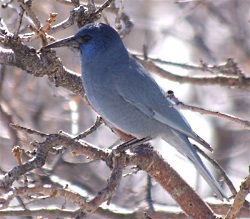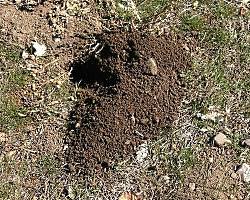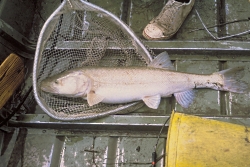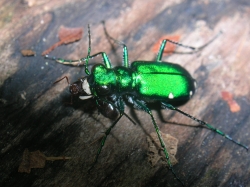
Courtesy & © 2005 Marlene Foard
As found on UtahBirds.org
 Pinyon Jay
Pinyon Jay
Gymnorhinus cyanocephalus
Courtesy US FWS
Dave Menke, PhotographerFew birds have such a strong association with one plant that the plants name becomes part of the birds name. Sage grouse is one, Acorn Woodpecker another, but the Pinyon Jay is our topic today. Pinyon Jays are usually found in close association with pinyon-juniper forests throughout the Great Basin and the nutritious nuts of the pinyon pine are their preferred food. The blue and grey birds collect and cache pinyon nuts in summer and fall for later consumption. They have an uncanny recovery accuracy and excellent spatial memory, which allows them to rediscover these scattered caches and eat pinyon nuts all year. They do not recover all the stored seeds, however, and therefore aid in the dispersal of pinyon pines.
Pinyon Jays have a complex social organization and are highly gregarious. [Pinyon Jay Audio Courtesy Kevin Colver]
They spend their lives in large flocks of up to 150 or more individuals. Nesting is communal, although rarely are there more than 2 or 3 nests per tree. Breeding season is in late winter. Many birds spend their entire lives in the flock into which they were born.
Pinyon Jays are not migratory, but they tend to be nomadic; traveling to wherever there is a good crop of pinyon nuts. They will also eat a wide variety of seeds, insects and berries to supplement their diet and can be found in adjoining sagebrush, ponderosa pine forest and riparian habitats. The conservation status of Pinyon Jays is considered vulnerable. Destruction of pinyon-juniper forests for grazing and changes in fire regimes have resulted in loss of habitat. And what is a Pinyon Jay to do without its pinyon nuts?
Thank-you to Kevin Colver for the use of his bird recordings.
This is Linda Kervin for Bridgerland Audubon Society.
Credits:
Pictures: Courtesy and Copyright © 2005 Marlene Foard, as found on utahbirds.org
Also Courtesy US FWS, David Menke, Photographer
Bird Recordings: Kevin Colver https://wildstore.wildsanctuary.com/collections/special-collections
Theme: Courtesy & Copyright Don Anderson as performed by Leaping Lulu
Text & Voice: Linda Kervin, Bridgerland Audubon Society
Additional Reading:
Gymnorhinus cyanocephalus (Pinyon Jay), Fire Effects Information, USDA Forest Service, https://www.fs.fed.us/database/feis/animals/bird/gycy/all.html
Avian Cognition Laboratory, Northern Arizona University, https://www4.nau.edu/acl/index.htm
Pinyon Jays, Utah Bird Profiles, UtahBirds.org, https://utahbirds.org/birdsofutah/BirdsL-R/PinyonJay.htm





